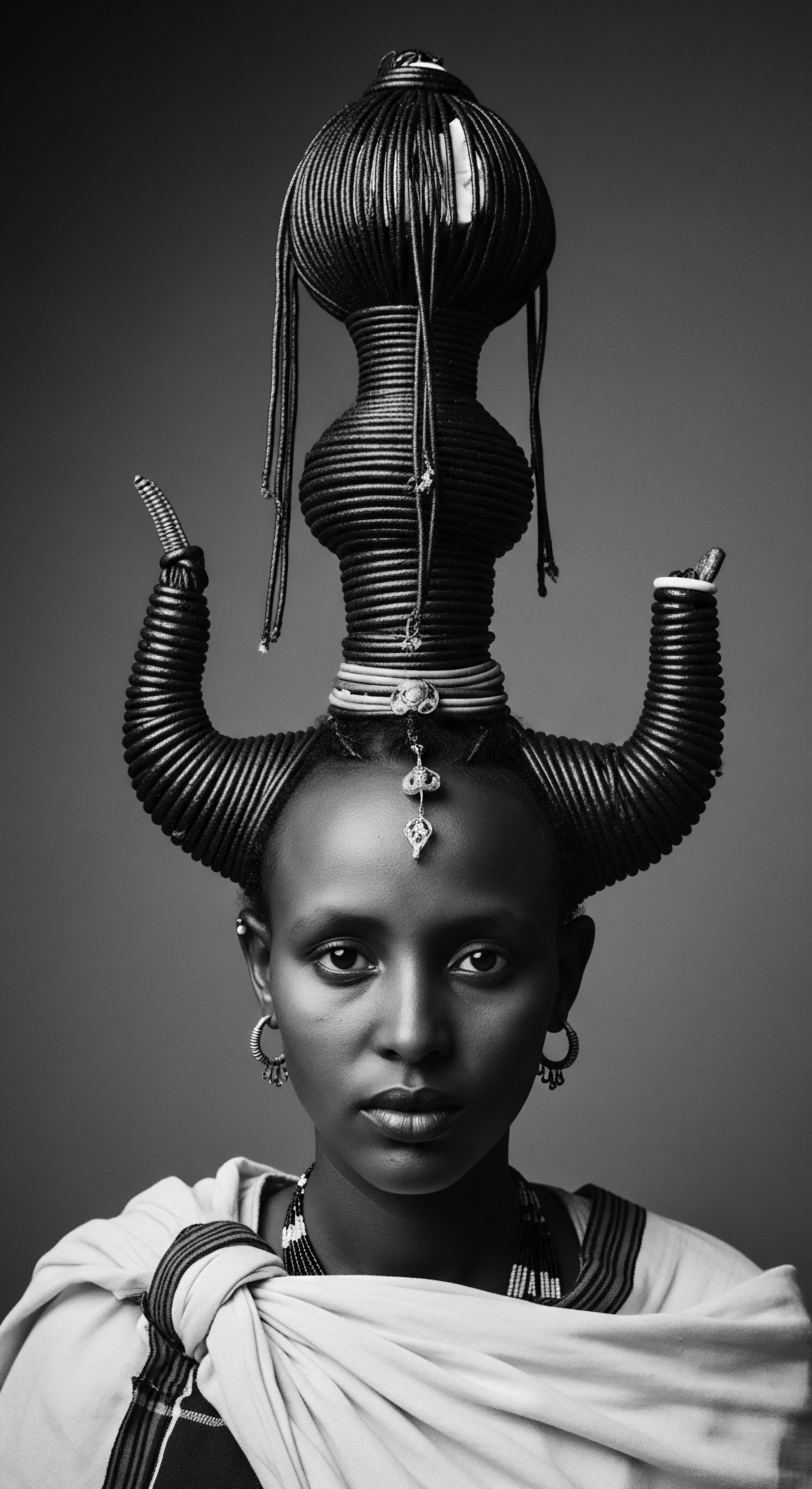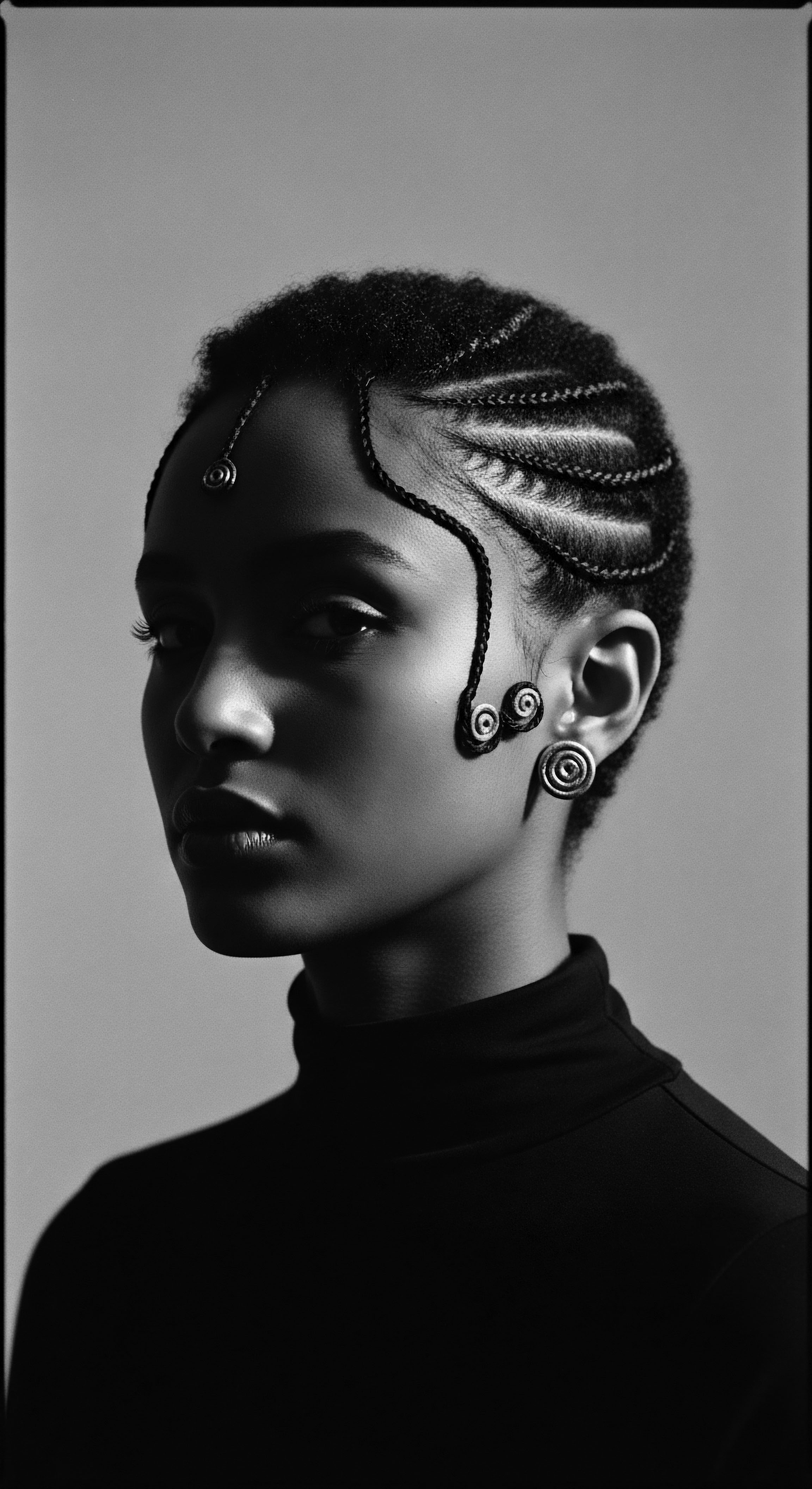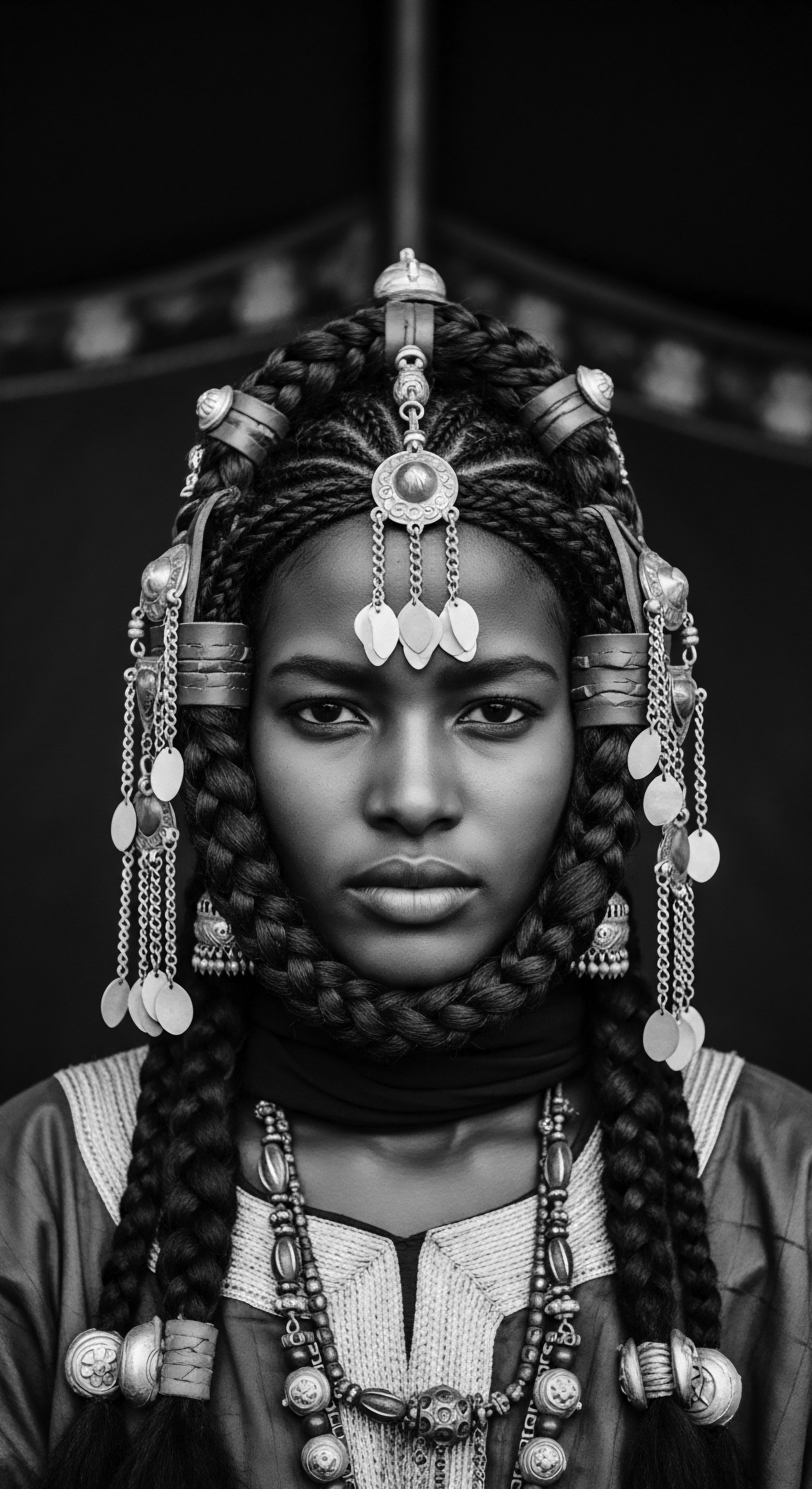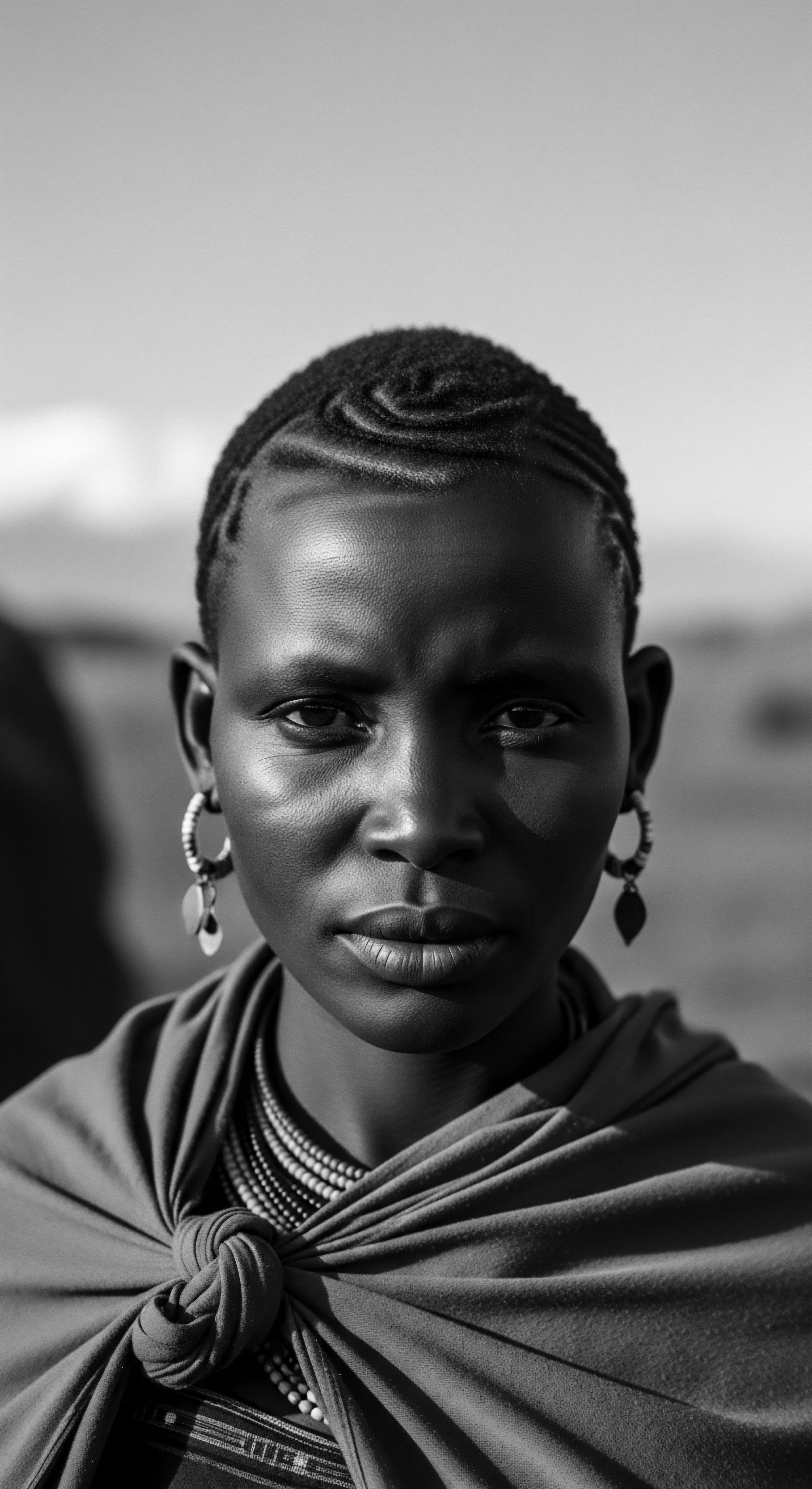
Fundamentals
The concept of Traditional Metal Craft, when viewed through the lens of textured hair heritage, delineates the creation and use of implements forged from elemental metals, shaped by skilled hands across generations, for the deliberate care, styling, and adornment of hair. This understanding extends beyond mere functionality, encompassing the profound cultural and spiritual significance imbued within these metallic forms. Such artisanal practices, often passed down through familial lines, speak to an intimate knowledge of materials and their capacities to interact with the unique biology of coiled and kinky hair strands. From the earliest human civilizations, metals like copper, bronze, and later iron, offered durability and versatility unmatched by organic alternatives, allowing for tools that could withstand repeated use and adornments that conveyed lasting messages.
The meaning of Traditional Metal Craft in this context is deeply rooted in ancestral ingenuity. It represents a living history of how communities interacted with their environments to solve practical challenges and express complex cultural narratives through hair. The earliest surviving examples of hair combs, dating back an astonishing 5,000 years, hail from Ancient Egypt and Sudan, often found in refined forms within settlements.
These were not simply objects of utility; they were also considered symbols of status and artistic expression, frequently worn within the hair as adornments. The delineation of this craft underscores a fundamental connection between the artisan, the metal, and the human spirit, all converging upon the crown, which in many African traditions, was revered as a spiritual gateway.

Early Expressions of Metalworking in Hair Traditions
Across the vast and diverse landscapes of Africa, communities discovered and refined techniques for working with various metals. This period marks the genesis of a connection between elemental strength and delicate hair care. Early tools for cleansing, untangling, and styling hair were often crafted from wood, bone, or ivory, yet the durability and malleability of metal offered distinct advantages for certain applications. These initial forays into metal craft provided implements that could more effectively manage the unique characteristics of textured hair, such as its inherent elasticity and tendency to coil upon itself.
Traditional Metal Craft illuminates an enduring bond between human ingenuity, the earth’s metals, and the sacred practices of textured hair care.
The earliest iterations of metal hair tools often manifested as combs. These were not merely detangling instruments; they served as potent visual markers. For instance, in Predynastic Kemet, combs were recognized as status symbols, and people frequently wore them within their hairstyles. Such a practice resonated across many African cultures, where the comb, often shaped as a ‘pik,’ carried symbols of animals or parts of animals on its handle, hinting at religious connections or affiliations with power.

Functional Innovations and Symbolic Depth
The crafting of metal objects for hair extended beyond simple combs to a myriad of adornments. These items, often made from gold, silver, brass, or copper, held immense cultural significance, communicating aspects of an individual’s identity, marital status, age, wealth, or tribal affiliation. The very act of forging these pieces became a sacred process, particularly in West African societies where blacksmiths were held in high regard, often perceived as possessing magical abilities due to their capacity to transform raw metal. Their work was fundamental to the growth and prosperity of communities, extending to tools, weapons, and ceremonial objects, alongside those intended for personal beautification.
As metalworking techniques evolved, so did the sophistication of the tools and adornments. The understanding of metal’s properties allowed for the creation of more precise and enduring objects, each carrying layers of meaning. This early period lays the foundational understanding that Traditional Metal Craft is not simply about shaping metal; it is about shaping identity, ritual, and communal narratives through the medium of hair.

Intermediate
Moving beyond the foundational understanding, the intermediate scope of Traditional Metal Craft unveils its dynamic meaning within textured hair heritage as a response to evolving social landscapes and aesthetic aspirations. This clarification of its import reveals how metal, in the hands of skilled artisans, became an agent of both practical transformation and profound cultural expression. The very term ‘Traditional Metal Craft’ in this context signifies not only the enduring techniques but also the continuous adaptation and re-interpretation of these methods to address the specific needs and desires related to Black and mixed-race hair. It is a testament to the ingenuity of a people who consistently found ways to honor their heritage while navigating new realities.

The Hot Comb ❉ A Complex Heritage
Among the most significant metal tools to impact textured hair in recent centuries is the hot comb, also recognized as a pressing comb. This heated metal tool, typically warmed over a stove or burner, applies pressure to hair strands to temporarily smooth and straighten coarse, coily, or kinky textures from root to tip. While its origins are often credited to Marcel Grateau in 19th-century France for use by European women, its widespread adoption and transformation into a cultural phenomenon within the Black community in America, particularly in the early 1900s, cannot be overstated.
This innovation provided Black women with a means to achieve straightened styles, a look often associated with social and economic advancement in a society that frequently devalued natural textured hair. The complex history of the hot comb highlights a period where hair care practices became entwined with survival, adaptation, and the persistent desire for self-determination amidst oppressive beauty standards.
The hot comb’s journey from a styling tool to a cultural icon reflects the intricate dance between conformity and self-expression within textured hair narratives.
Annie Malone and Madam C.J. Walker played pivotal roles in popularizing the hot comb and developing accompanying hair care products, building empires that addressed the specific needs of Black hair. Malone, observing the detrimental effects of slave labor, weather, and lack of hair care products on Black women’s scalps, was inspired to create a range to foster healthier hair. Madam C.J.
Walker, a student of Malone, further cemented the hot comb’s place by integrating it into her patented pressing system and offering it to her trained hairdressers. This era demonstrates how traditional metal craft, adapted for new purposes, became central to a burgeoning industry focused on Black hair wellness and styling.

Symbolic Metal Adornments in African Hair Traditions
Beyond functional tools, metal also played a crucial role in hair adornment, serving as a powerful visual language across African societies. The application, delineation, and interpretation of these metallic elements within hairstyles communicated a wealth of information about an individual’s place within their community. For instance, the Fulani people of West Africa, renowned for their intricate braid patterns, often adorn them with silver or bronze discs, which are sometimes heirlooms passed through generations. Similarly, in Yoruba culture, beads made from gold, silver, or other materials were incorporated into hairstyles, reflecting wealth, status, and spiritual connection.
The Zulu people of Southern Africa also utilized metal in their hair traditions, with accounts mentioning metal pieces or beads decorating aprons or even being braided into hair and headdresses to signify profession or status, particularly among traditional healers known as sangoma. The Fante of Ghana, as early as the nineteenth century, wore elaborate coiffures adorned with gold ornaments to announce eligibility for marriage. These practices extend the meaning of Traditional Metal Craft to encompass a profound system of non-verbal communication, where the gleam and form of metal in hair became an eloquent expression of identity and belonging.
| Culture/Region Ancient Egypt/Sudan |
| Metal Craft Application Metal Combs (often 'piks') |
| Cultural Significance/Meaning Status symbols, ceremonial objects, detangling tools |
| Culture/Region West Africa (General) |
| Metal Craft Application Metal Adornments (beads, rings, discs) |
| Cultural Significance/Meaning Indicated tribal identity, marital status, wealth, spiritual beliefs |
| Culture/Region Yoruba (Nigeria) |
| Metal Craft Application Gold and Silver Beads in Hair |
| Cultural Significance/Meaning Symbols of wealth, royalty, spiritual connection (e.g. Oba's Crown) |
| Culture/Region Zulu (Southern Africa) |
| Metal Craft Application Metal Pieces/Beads in Headdresses/Hair |
| Cultural Significance/Meaning Professional identity (sangoma), status, part of traditional attire |
| Culture/Region African Diaspora (early 1900s U.S.) |
| Metal Craft Application Hot Comb/Pressing Comb |
| Cultural Significance/Meaning Tool for temporary hair straightening, associated with social acceptance and economic opportunity, also a point of cultural adaptation |
| Culture/Region These examples collectively underscore the deep, enduring connection between metal artistry and the lived experiences of textured hair communities across time and geography, shaping practices and identities. |
The continuous evolution of Traditional Metal Craft, particularly in its interaction with textured hair, serves as a powerful historical document. It chronicles not only the development of metallurgical skills but also the complex social narratives, adaptive strategies, and persistent expressions of beauty and identity that define the heritage of Black and mixed-race hair. The ways these metallic elements were utilized, from practical tools to sacred adornments, clarify their substantial impact on both daily life and grand ceremonial practices, underscoring their irreplaceable meaning within these traditions.

Academic
The academic meaning of Traditional Metal Craft, when rigorously explored through the distinct lens of textured hair heritage, transcends a mere technical explanation of metallurgy to reveal a profound cultural anthropology of care, identity, and resilience. This explication posits Traditional Metal Craft not as an isolated discipline, but as an deeply interconnected matrix of ancestral knowledge, elemental biology, and socio-historical experience, particularly within Black and mixed-race communities. It encompasses the skilled shaping of metals into objects whose very forms and applications delineate the complex relationship between hair, personal agency, and societal structures.
This understanding is grounded in the recognition that for millennia, the manipulation of iron, copper, gold, and other metals provided tools and adornments integral to the maintenance, beautification, and symbolic communication inherent in textured hair traditions. The statement of its comprehensive meaning requires an interdisciplinary approach, drawing from archaeology, ethno-history, material culture studies, and the burgeoning field of Black hair studies.
A core aspect of this academic exploration is the elucidation of how metal tools facilitated specific biomechanical interventions on hair structures. For instance, the high thermal conductivity of metals, when applied through tools like the hot comb, allowed for temporary denaturation of the hair’s keratin bonds, facilitating a temporary straightening effect. This scientific understanding, however, gains its true significance when contextualized within the social pressures that necessitated such modifications.
The historical context reveals that the widespread adoption of hot combs in the early 20th century, while offering new styling possibilities, also became a mechanism for navigating pervasive anti-Blackness and discriminatory hiring practices that favored straightened hair textures. The craft, therefore, embodies a complex duality ❉ a testament to technological adaptation and a poignant reflection of societal constraints.

Echoes from the Source ❉ Blacksmiths and the Ancestral Hearth
The very act of forging metal has always held a sacred, almost alchemical, significance in many African societies, particularly in West Africa. Blacksmiths, often belonging to endogamous castes, were considered not just artisans but custodians of powerful knowledge, believed to manipulate a vital force called nyama among the Mande people, which represents both energy and the organizational essence of their world. Their craft, which included the production of agricultural tools, weapons, and ceremonial objects, extended naturally to elements for personal adornment, including those for hair. The significance, intention, and purport of these metal objects were thus intrinsically linked to a worldview where the material world was infused with spiritual resonance.
In Yorubaland, the god Ogun, associated with iron and war, stands as a central figure in mythology, embodying the transformative power of the blacksmith. The forge itself was often perceived as a ritual shrine, a sanctuary where profound transformations occurred. This deep respect for metalworking meant that hair adornments and tools crafted from metal were not mere accessories; they were extensions of spiritual belief, community identity, and the very fabric of existence. The conceptualization of Traditional Metal Craft thus demands a recognition of these ancient, holistic frameworks.

The Tender Thread ❉ The “Jimcrow” Comb as a Case Study of Resilience and Adaptation
To truly comprehend the depth of Traditional Metal Craft within textured hair heritage, one must confront its more challenging historical iterations, particularly during periods of profound oppression. A striking and often under-examined example is the enforced use of the “jimcrow” comb by enslaved Africans in the Americas. This tool, most akin to a wool carder—a paddle brush equipped with sharp metal teeth designed for detangling sheep’s wool—became a brutal substitute for the traditionally carved wooden combs with wide, rounded teeth used in Africa for managing delicate, coily hair.
The ‘jimcrow’ comb stands as a painful testament to the weaponization of metal craft, transforming a tool of care into an instrument of racialized trauma.
The shift from gentle, culturally appropriate hair tools to this harsh implement had devastating consequences. It caused significant damage, including heavy dandruff, alopecia, scalp conditions, and hair loss, a stark contrast to the nourishing, community-based hair care rituals of pre-slavery Africa. Enslaved people, stripped of their traditional oils, butters, and combs, resorted to substances like lard, bacon fat, or goose grease, which were readily available, to lubricate their hair in an effort to mitigate the damage inflicted by these crude metal tools. This period profoundly altered hair care practices, forcing an adaptation rooted in survival rather than wellness.
The enduring substance of Traditional Metal Craft in this context therefore embodies not only the material object but also the profound human experience of enduring, resisting, and finding ways to maintain connection to self and heritage despite immense adversity. This narrative underscores the notion that even in the face of dehumanization, hair remained a site of identity, even if it had to be covered by headscarves to conceal the physical wounds of enforced practices.
The memory of such tools and their impact continues to echo through contemporary Black hair experiences, shaping collective consciousness around hair health, the politics of presentation, and the ongoing reclamation of natural textures. The ‘jimcrow’ comb serves as a specific historical example demonstrating how the material characteristics of metal (sharpness, rigidity) were brutally misapplied, leading to physical harm and psychological distress. This particular historical incidence, rigorously backed by historical accounts (Byrd & Tharps, 2001), offers an expert-specific insight, often less commonly cited in broader discussions of hair tools but critical for a deep understanding of Traditional Metal Craft’s complex relationship with Black hair heritage.

The Unbound Helix ❉ Metal as an Expression of Identity and Heritage
Despite the hardships documented, Traditional Metal Craft also remained a powerful medium for expressing identity and cultural continuity. In many societies, the artistry of metalworking found its most eloquent expression in the adornment of hair, signifying profound social and spiritual meanings.
- Adinkra Symbols ❉ These visual representations from the Akan people of Ghana are often integrated into metal jewelry, including those for hair. The ‘Duafe’ symbol, a wooden comb, represents femininity, beauty, and care, underscoring the enduring connection between grooming tools and cultural values, even when rendered in metal.
- Hair Beads and Rings ❉ Across North Africa and parts of the Sahel, metal beads, rings, and discs were, and continue to be, meticulously incorporated into braided hairstyles. These are not merely decorative elements; for the Mauritanian people, silver metal beads called aggrab el-fadda refer to fertility and prosperity, often tied into braided hair strands. Similarly, Fulani women wear silver or bronze discs on intricate braid patterns, sometimes passing them down through generations.
- Ceremonial Ornaments ❉ In contexts like traditional wedding ceremonies in Nigeria, coral beads worn as crowns, often with metal elements, signify significant cultural meaning and authority. These forms of metal craft become tangible embodiments of cultural continuity, connecting contemporary practices to ancestral lineages.
The exploration of Traditional Metal Craft within textured hair heritage therefore offers a sophisticated understanding of cultural adaptation, resistance, and the enduring power of self-expression. The careful study of these objects, their creation, and their use, provides a richly textured interpretation of human experiences, particularly within the Black and mixed-race diaspora, illuminating how the material world of metal has shaped, and been shaped by, the profound heritage of hair. The enduring meaning of this craft is found in its capacity to serve as a silent yet potent archive of shared histories, communal values, and unwavering resilience.

Reflection on the Heritage of Traditional Metal Craft
The journey through Traditional Metal Craft’s relationship with textured hair heritage leads us to a space of profound reverence, where the strength of metal intertwines with the delicate resilience of each strand. We have witnessed how the very earth yielded its treasures to hands that sought to nurture, to adorn, and to define. This exploration underscores the enduring legacy of ancestral wisdom, a deep well of knowledge from which contemporary understanding continues to draw. The narrative of metal craft in hair care is not a static historical record; it is a living, breathing archive that speaks to adaptability, profound creativity, and an unyielding spirit.
From the meticulous forging of combs in ancient Kemet, designed with thoughtful spacing for coily textures, to the intricate metal adornments that whispered tales of status, lineage, and spiritual connection in West African societies, the connection is undeniable. Even the challenging story of the ‘jimcrow’ comb, a harsh metal implement forced upon enslaved ancestors, reveals a bitter truth about adaptation under duress, yet it also highlights the unwavering commitment to hair care, even when resources were brutalized and scarce. This historical trauma, acknowledged with sensitivity, deepens our appreciation for the subsequent reclamation and re-interpretation of hair practices within the diaspora.
The legacy of Traditional Metal Craft calls upon us to recognize the deep meaning embedded in every tool and ornament, an unbroken lineage that connects our present to a rich and vibrant past. It invites us to honor the hands that shaped the metal, the minds that conceived the designs, and the individuals whose hair carried these powerful symbols through time. This heritage provides a profound grounding, reminding us that hair is not merely a biological attribute; it is a canvas, a conduit, and a testament to our shared history and collective strength.
As we continue to care for our textured hair, we carry forward these ancestral echoes, weaving the wisdom of the past into the boundless possibilities of the future. The enduring significance of metal in hair heritage persists as a potent symbol of identity, tradition, and the soul of a strand.

References
- Byrd, A. L. & Tharps, L. L. (2001). Hair Story ❉ Untangling the roots of black hair in America. St. Martin’s Press.
- Dewey, W. J. & Childs, S. T. (1996). The Art of the Luba ❉ An Introduction. African Arts, 29(4), 66-77.
- Lawal, B. (2000). Hair in African Art and Culture. In R. Sieber & F. Herreman (Eds.), Hair in African Art and Culture (pp. 98-103). Museum for African Art.
- Schettler, M. et al. (1992). Hair Styles from Namibia. Journal of African Art, 25(1), 39.
- Sieber, R. & Herreman, F. (Eds.). (2000). Hair in African Art and Culture. Museum for African Art.
